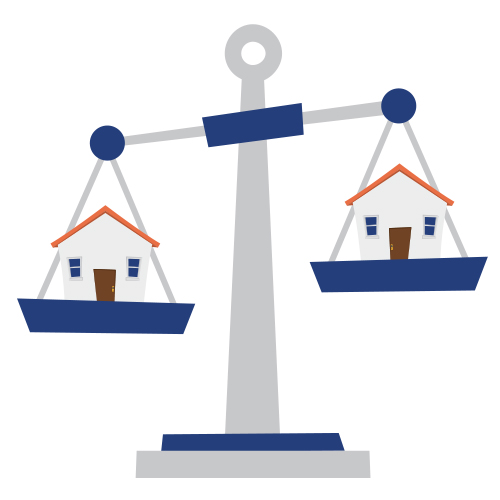One of the most important decisions in a house flip is where you’ll be buying a house. you want to make sure you consider the best places for flipping houses. Many advisors will tell you to look for hot markets in different states, but it really comes down to the qualities of a location. You can find great opportunities to flip houses no matter where you are, as long as you know what to look for. Here are some telltale signs that your fix and flip is in a desirable location.
1. Look for Popular Markets
There is an old and common expression that there are three rules of real estate investing: location, location and location. When it comes to finding the best markets for flipping houses, nothing is more important than picking a location where there is demand for the house you are rehabbing. You can build a beautiful home and offer it for a great price, but if it is not in an area where your target customer wants to live, you will not be able to sell it. The best ways to gauge demand in the area for your potential house flip are to network with local realtors and search through sites like Realtor and Zillow to compare properties that are for sale.
 When searching online for property supply and demand, make sure to stay within a close range of the target block for your house flip. How close you need to stay depends on the housing density of the neighborhood. In densely populated urban areas, a few blocks should be enough, in more spread out suburban and rural areas, it may be necessary to expand your area to a few miles. But, always try to stay within the same school district.
When searching online for property supply and demand, make sure to stay within a close range of the target block for your house flip. How close you need to stay depends on the housing density of the neighborhood. In densely populated urban areas, a few blocks should be enough, in more spread out suburban and rural areas, it may be necessary to expand your area to a few miles. But, always try to stay within the same school district.
Find listings similar to your house flip in size, square footage, room count and improvements, then track them for a while. See how long they are listed for. Watch how many times price adjustments are made. Do this for a few months before committing to a purchase. You can also network with local realtors to see how many showings the houses are getting, what people like and don’t like about them, what is selling, for how much, and what differentiates them from properties that remain unsold.
If very few houses are selling in the area, then you may need to concentrate on another market for your house flip, as there may not be sufficient demand for your product to make the deal profitable for you. In some areas, there is demand, but buyers are very price sensitive. If you know the “magic price point” for the area before you purchase the house, you can plan your purchase and house flip accordingly. This will help to make sure you buy smart and keep your rehab costs under control. If you cannot bring the project in below the desired price, you should not start the project.
2. Consider Material and Personnel Cost
How much does it cost to flip a house in your target market?
It’s no secret that it costs more money to get things done in New York City than it does in Cleveland. Material and personnel costs are no different. The more robust the local economy, the higher the average cost of flipping a house will be. On the flip side, however, real estate prices are going to be higher in the more expensive markets, so in the end, it generally always works itself out. The key is to not pay too much for materials and personnel, regardless of the area you are working in.
Shop around for a contractor for your house flip. Get at least three itemized bids for your rehab, and compare them line by line for each item. Have your contractor price out materials separately, and then double check the pricing before signing a contract. The contractor should be able to get better prices than you can, as most home improvement stores give a discount to contractors. If you can get the same prices he quotes you, you should probably find another contractor. If he wants to make money on the materials, fine, but you should know that, and the labor cost should then be lower than contractors that are just passing through the direct expense of the materials to you at cost.
If you are buying the materials yourself, shop around. Generally, the big box home improvement stores are less expensive than neighborhood stores. Check for sales – buy what you need at the time you need it, do not buy everything at once, as you never know when a big item will be reduced in the future.

Don’t forget about Unexpected House Flipping Costs!
 Nothing is more important to your rehab project than picking a location with foreseeable growth.
Nothing is more important to your rehab project than picking a location with foreseeable growth.
 3. Look for a Catalyst
3. Look for a Catalyst
With any house flip, the real estate investor should be constantly searching for a catalyst. The things that will affect a local market in a small city are different than those in a larger, more populated environment. In a small city, news of a major employer leaving or coming in can cause significant swings in real estate values. In a larger city, real estate markets are more affected by trends, rather than specific employers and individual occurrences.
What will affect all markets, regardless of size, however, are things like crime rates, proximity to municipality infrastructure improvement, reputation of local schools, and the opening of new businesses in the area. There is nothing that picks up values faster than a couple of new trendy restaurants!
A savvy house flipper will look for neighborhoods where good things have been approved and are being built, like a new highway, commuter line expansion, etc. Increased accessibility to highways and public transportation are always draws to a neighborhood.
In addition, investment by third parties, such as merchants building food stores, restaurants, recreation centers, day cares, etc. all bring value to a neighborhood. An end buyer of a house is looking for life’s conveniences. If the supermarket, dry cleaner and gasoline station are relatively close, it points towards a better quality of life for the homeowner and a higher after repair value for a house flipper.
The smart house flipper will follow the local news and try to use public information to anticipate where the next hot areas of growth are going to be. These are likely to be some of the best markets for flipping houses. By the time all of the improvements are actually made to a neighborhood, it is probably too late to benefit and maximize the profit potential.
4. Pay Attention to School Rankings
Anyone who has children knows that where children go to school is first and foremost in most home buyers minds. When looking at comparable sales of your target house flip, make sure they are in the same school district, even the same schools if possible. Nearby homes that are in a different school area are not really true comparisons, as certain districts are viewed as more desirable and prestigious than others.
Even if the end buyer does not have children, they will still be concerned about the school district, and so should you. Everyone down the line in the ownership of the property will need to sell it at one point, and pricing it too high for the district will make it harder to sell. Conversely, if your property is in a very desirable district, make sure you maximize the full value of the access to education in the area.
Every house has a potential buyer, regardless of the school district. The key, however, is to understand where the house physically sits, and price it correctly based on a number of factors, including the local schools.
 4. Know the Local Taxes
4. Know the Local Taxes
Do not underestimate the effect that real estate and school taxes can have on the pricing and salability of a house. The higher the real estate taxes, the lower the selling price of the house has to be to compensate the borrower for the added tax burden. Often, it is not the price of the house, but the annual real estate and school taxes that have the most impact on a potential buyer’s ability to afford a home.
As with the local school district and other factors, make sure that when you are looking at comparable sales that you are looking within the same municipality and county as the subject property. If you don’t, the comparisons may paint a false picture of the after repaired value of a property. You must make sure that you are looking at true comparisons, and not just houses that look like the one you want to invest in.
Also, remember that you are going to have to pay the real estate and school taxes during your house flip, and that is money out the door that must be accommodated in your pre-purchase financial planning.
 To help you determine if you are investing in a promising market, learn how to do a CMA.
To help you determine if you are investing in a promising market, learn how to do a CMA.


 3. Look for a Catalyst
3. Look for a Catalyst 4. Know the Local Taxes
4. Know the Local Taxes